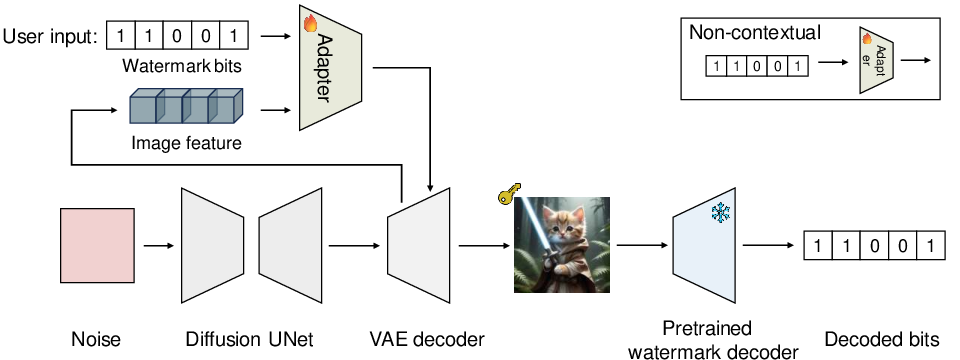- The paper introduces WMAdapter, a novel method that embeds watermark control into latent diffusion models for robust copyright protection.
- It employs a Contextual Adapter structure with a Hybrid Finetuning strategy to balance image quality and resilience without per-watermark finetuning.
- Experimental results on MS-COCO 2017 demonstrate near-perfect tracing accuracy with enhanced metrics like PSNR and SSIM.
WMAdapter: Adding WaterMark Control to Latent Diffusion Models
Introduction
The research presented in "WMAdapter: Adding WaterMark Control to Latent Diffusion Models" introduces WMAdapter, a watermarking solution embedded within latent diffusion models to ensure copyright protection and secure the integrity of AI-generated images. Traditional watermarking often requires separate operations outside the diffusion model, whereas WMAdapter seamlessly integrates the watermarking process directly into the image generation pipeline. This approach ensures minimal disruption to the core image generation process while offering flexibility and high-quality outputs.

Figure 1: Framework overview. WMAdapter is plugged onto the VAE decoder. It takes user input watermark bits and image features from the VAE decoder, imprinting the watermark on-the-fly during VAE decoding.
Methodology
The WMAdapter is designed to address scalability issues associated with previous watermarking methods by eliminating the need for per-watermark finetuning. The architecture employs a Contextual Adapter structure, which enhances knowledge transfer by taking both watermark bits and image features as input. This dual conditioning leads to more adaptive and visually appealing watermark integration, critical for high-quality image generation.

Figure 2: The architecture of WMAdapter. It comprises several independent Fusers with identical structures.
The training process for WMAdapter involves two stages: a large-scale training phase where the adapter is trained, leveraging a pretrained watermark decoder, and a finetuning stage designed to improve image quality further. The novel Hybrid Finetuning strategy enhances image sharpness while using the original VAE decoder during inference, effectively balancing robustness and quality.
Experimental Results
Empirical results demonstrate that WMAdapter maintains competitive robustness against common image alterations such as cropping and JPEG compression while ensuring high image quality. The experiments, conducted on the MS-COCO 2017 dataset, showcase WMAdapter's ability to adapt across various user scales, maintaining near-perfect tracing accuracy among different user pools.

Figure 3: Illustration of 3 different finetuning strategies. They differ in how to treat the VAE decoder.
Robustness and Image Quality
WMAdapter's bit accuracy remains consistent across various distortion levels and demonstrates resilience to neural auto-encoder-based compression. Compared to other watermarking techniques, WMAdapter offers enhanced image quality metrics, including PSNR and SSIM, indicating a superior balance between invisibility and robustness. The qualitative assessments also highlight WMAdapter’s capacity to produce sharper images with fewer artifacts compared to other methods like Stable Signature and traditional post-hoc approaches.
Implications and Future Work
The introduction of WMAdapter signifies a step forward in integrating watermarking within the diffusion process, offering a practical approach without sacrificing image quality. Its scalability and flexibility are particularly advantageous for large-scale deployments. Future research may explore expanding WMAdapter to accommodate video generation models or further enhance robustness against emerging image manipulations.
Conclusion
WMAdapter provides a novel integration of watermarking within latent diffusion models, achieving a practical balance between robustness, flexibility, and image quality. Its lightweight nature and adaptability make it a compelling solution for contemporary challenges in digital image copyright protection. Future developments can leverage WMAdapter's foundational architecture to explore broader applications in media integrity and security.


